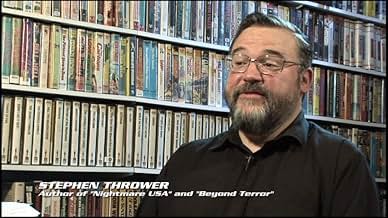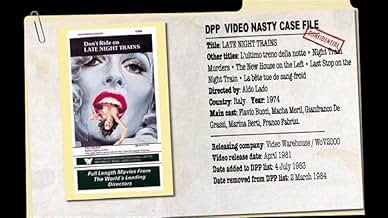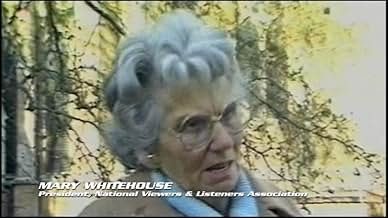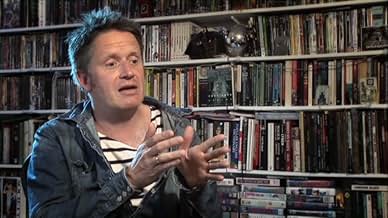Agrega una trama en tu idiomaA documentary analyzing the furor which so-called "video nasties" caused in Britain during the 1980s.A documentary analyzing the furor which so-called "video nasties" caused in Britain during the 1980s.A documentary analyzing the furor which so-called "video nasties" caused in Britain during the 1980s.
- Self
- (material de archivo)
- Self
- (material de archivo)
- Self
- (material de archivo)
Opiniones destacadas
In the last few years or so, I have caught up with most of the infamous video nasties and on an alarmingly common basis wondered how in hell they were ever considered obscene in the first place. Of course, I don't refer to all of them when I say this; movies such as Cannibal Holocaust and The House on the Edge of the Park remain deeply troubling movies, while Faces of Death is guaranteed lasting infamy for its real death footage. But when viewing films such as Funhouse or Visiting Hours, amongst many others I just couldn't get to grips with how they could have fallen foul of the law to such a massive extent. As it turned out the 72 nasties were eventually whittled down to 39 'true' video nasties that were considered the extreme of the extreme Although when you consider that this final list included the innocuous The Werewolf and the Yeti you are still left wondering about the thought process that produced this final list.
This documentary looks at the thinking behind the panic and the way the authorities acted. It was driven by politicians, puritans and Mary Whitehouse. The tabloid press were possibly the most influential of all though, informing the public that the sadistic videos were not only pernicious but that some were even genuine snuff movies. All of this was eaten up of course and titles with tabloid friendly, memorable names such as The Driller Killer became poster boys for all that was wrong with the new home video entertainment. Although most of us never actually thought about it at the time but the reason the market was flooded with low budget horror titles in the first place was that when the home video format first emerged, the big American studios refused to release their movies onto it seeing it as a competitor to their cinematic offerings. Consequently, lots of small traders emerged and bought up packages of cheap films, often very obscure and with a large percentage being horror flicks. And with this historical context, the early 80's home video horror boom was born.
In fairness, it isn't very surprising that the Video Recording Act happened. It does seem insane that these films weren't age certificated in some way. It's also not hard to understand why a lot of folks were uncomfortable when they were presented with lurid promotional posters for the likes of S.S. Experiment Camp. We have been desensitised these days to film violence and you really have to take into account the historical context to understand the genuine shock that these films engendered. So the documentary looks at why the furore happened and it allows both sides of the argument fair air time to present their case. It would only be fair to say that the film is clearly on the side of the defenders but I did think that it allowed the other side of the argument a fair hearing and didn't make them look silly with cheap editing or anything. We get to see short clips of all the 72 films but in the final analysis, this is not about the films themselves. It's about what caused the Video Recordings Act of 1983 to come into place. If you have knowledge of the subject there probably won't be too much new here although I am certain you will learn a few new nuggets of information. If, on the other hand, you have no, or limited knowledge, of the whole video nasty phenomenon then this is as good a place to start as any.
Anyone here remember the luridly awesome looking covers at your local fleapit video shop, the type of shop where you just knew the owner was kinda dodgy? They were gonna corrupt us, deprave us, and turn us all into thrill killing time bombs. Or so the powers that be apparently thought at the time, and decided that enough was enough as they certainly knew what was best for us all.
This documentary explores this mindset, its consequences, how it affected people and its possible effects in regards to today.
Jake West lets each camp equally give their opinion, and is more than happy to give advocates of the Video Recording Act enough rope to hang themselves by coming out with patently ludicrous views. West also highlights the unscrupulous and fraudulent methods used by advocates of the ban and Video Recordings Act, in regards to statistical data to back their claims of films being able to morally corrupt, and how said data was gotten.
The doc also features insightful comments from the likes of Neil Marshall, Christopher Smith, Kim Newman, Alan Jones and Stephen Thrower and is well worth checking out for any self respecting horror fan, particularly UK fans and particularly fans who were around at the time of the era.
It's nothing especially new- the topic has been covered in the also excellent Ban The Sadist Videos documentaries- but it's a cracking and often amusing documentary all the same.
Not much else to say really, except that it's great and is well recommended for any horror fan. 9/10, an absolute treat.
Now something interesting here is that thanks to my good friend Duncan from the Podcast Under the Stairs, I knew most of the information. I've listened to most of his shows from the TPUTS Collective of Doing the Nasty where they were covering the films from all three lists. The introduction pulls soundbites and this theme song from this documentary. That still didn't diminish my enjoyment of this. I was born in the 1980s and in the United States, so when this was going on, I had no idea. It is quite interesting.
What I like most about this documentary is that it tells both sides of the story. We are getting great film critics like Alan Jones, Kim Newman, Julian Petley and Stephen Thrower telling their side. What is interesting then to go along with them is hearing from British filmmakers like Christopher Smith and Neil Marshall. Then on the other side of this, we hear from people who were in favor of the ban like Graham Bright, who introduced the Video Recordings Act 1984. The best documentaries try not to be completely biased so I give credit here.
This is also a well-made documentary. There is a funny part in the beginning when they talk to people who used to seek these films out. They talk about how you could tell when a gory part or nudity was coming because the quality would dip. Having grown up with VHS tapes, I do remember that. What is fun is that the quality of what we're watching mimics that. This does well in editing in footage to help show things they were talking about. I'm glad I finally sought this out. This definitely gives an interesting introduction to this period of British history and to this list of wild films, which were added for a variety of reasons.
My Rating: 8 out of 10.
First of all, as an American reviewing this, I was not "there" when this all happened. Maybe that makes it even more enjoyable today. And it also makes watching what happened even more unbelievable and shocking, so let's get to it.
This set seems to be the be all, end all of what you need to know about video nasties all packed into a three-disc set running over thirteen hours in total. If you were a lucky person (and I wasn't) some of the early copies were sold with replica lobby cards advertising some of the nasties talked about in the film.
The set starts off with the documentary, Video Nasties; Moral Panic, censorship and videotape. While being greatly informative and interesting, I felt it was too short as the run time for this was only about 72 minutes. This could have run at least another hour without me losing any interest whatsoever, because the subject is so fascinating. It includes snippets of interviews from both pro and con camps. Mary Whitehouse, Graham Bright and others make appearances in new and archival footage, and the history of what happened with the early 80's videotape scare is made very clear, even if you weren't from England. Archival news reports as well as new footage from reporters is used to illustrate how intense this issue was in the day, and how it seems to have never really gone away entirely as censorship can still be found in movies new and old to this day in England.
While I found the documentary fascinating and should have been the meat and potatoes of this package, it is not. Surprisingly, its the extras which makes this set a must own for all collectors of horror cinema.
The extras on disc one (including two Easter eggs) are as follows. You get almost an hours worth of pre-cert video company identifications. This could be boring for some, but I enjoyed looking at them, and recognizing a few of them myself (Thorn-EMI for one). This will be more nostalgic for VHS tape collectors, and for those across the pond who have seen these often. Last on Disc one is an image gallery showing artwork from the 80 titles on the DPP's section 3 list. These are all VHS covers and look wonderful on the screen.
Disc two starts the amazing reviews and trailers of the video nasties. all original trailers are filmed with new introductions from some of the people who appeared in the documentary. Kim Newman, Marc Morris, Neil Marshall and other experts do the honors to introduce the nasties and their trailers. This portion concentrates on the 39 nasties that were successfully prosecuted in the UK courts. Plus you get another image gallery for those 39 video releases.
Disc three continues along the same path, with the guests introducing the trailers for the 33 nasties that were initially banned, but then acquitted and removed from the DPP list. Plus you get to see the image gallery for those covers as well.
All of the trailers look to be in the correct aspect ratio and seem to have been cleaned up as much as possible considering the rarity of some of them. The introductions are concise, insightful and genuinely honest about the material and you can learn what nasties seem to be the most popular, the best to watch, and which ones to avoid. To the collector though, the DPP list is a dream list to be able to collect all the nasties, good or bad, to be able to proudly say you own them all.
As I said in the beginning, this is a must own for all horror collectors. It will take you back in time with its documentary, and it will give you something to enjoy and study with its commentary and nasties trailers. I believe that this might be the final word on the subject of the video nasties And if not, surely it will rank among the most enjoyable. Go out and get yourself a copy of this now.
It starts by evoking the feeling of how it was to get and see those gruesome horror movies when VHS first came out in the late 70s. It also repeatedly degrades the picture quality to a crummy low-fi picture that is very authentically VHS-like. Then it goes down to business and we get a history lesson about how the video nasties list came to be, the censorship and VHS burnings in the UK,... People from both sides are interviewed, those who fought against the censorship but also those who wanted to enforce it, everything for the sake of recreating those events. For some good measurement some British young horror filmmakers and Kim Newman are thrown into the mix talking about how they perceived it and how those films even influenced their movie making. It's not about the individual video nasty movies, though, although you get to see some bits and pieces from them throughout. Balanced, well-made and works well as a time capsule bringing you back to your childhood. The 3-DVD-box set is available now...in a VHS case.
¿Sabías que…?
- TriviaAvailable as part of Nucleus Films 3 disc DVD set "Video Nasties: The Definitive Guide".
- Citas
Martin Barker: And I think... the most interesting thing to me is just how little historical memory we have. The next time there's a panic, we won't remember just how stupid the last one was and how people get away with things. And that to me is the most important lesson about this campaign. The evangelicals got away with murder. They got away with fraud. They got away with deceiving people. They now laugh it off and the fact that all these films, almost all these films are now available uncut in the public domain... they don't care. Because they move on, because what they want to do is dominate the present and they don't care about history. Critical voices have to care about history. We have to care about the way in which things got controlled in the past because that's when the damage gets done. And if we don't keep that historical memory, we will allow them to do it again next time.
- ConexionesFeatured in Half in the Bag: Censor (2021)
Selecciones populares
Detalles
- Fecha de lanzamiento
- País de origen
- Idioma
- También se conoce como
- Video Nasties: The Definitive Guide
- Productora
- Ver más créditos de la compañía en IMDbPro
- Tiempo de ejecución1 hora 12 minutos
- Color
- Relación de aspecto
- 1.78 : 1
Contribuir a esta página
































